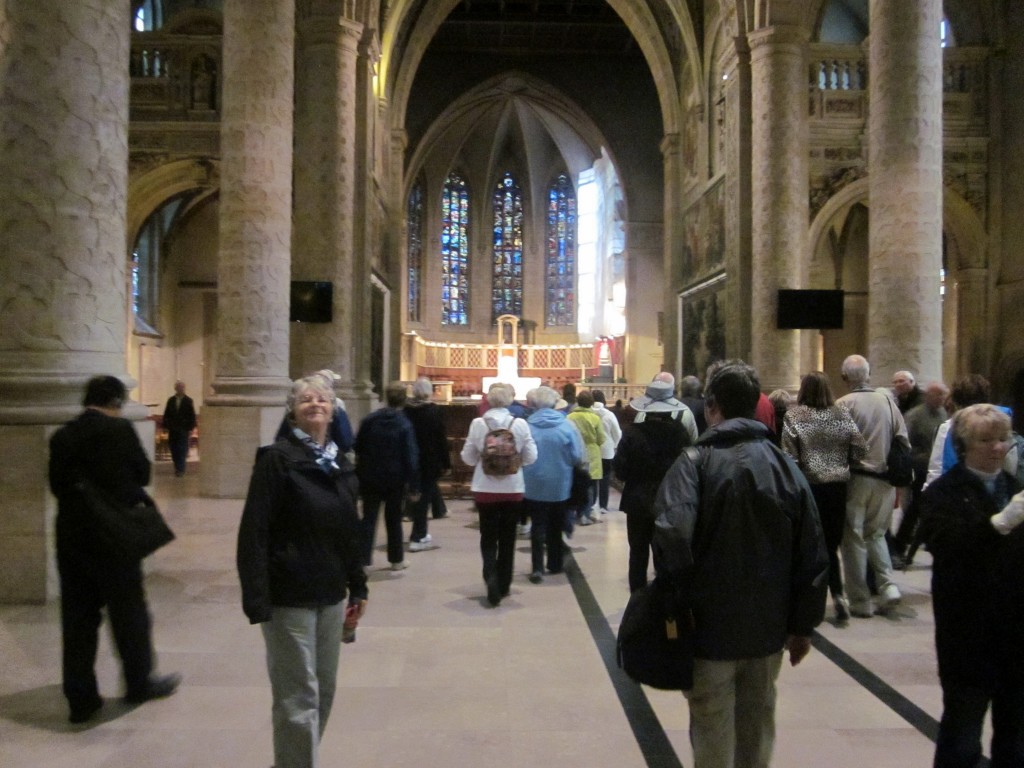This is some of the scenery we enjoyed:
The Metternich Castle and Vineyards
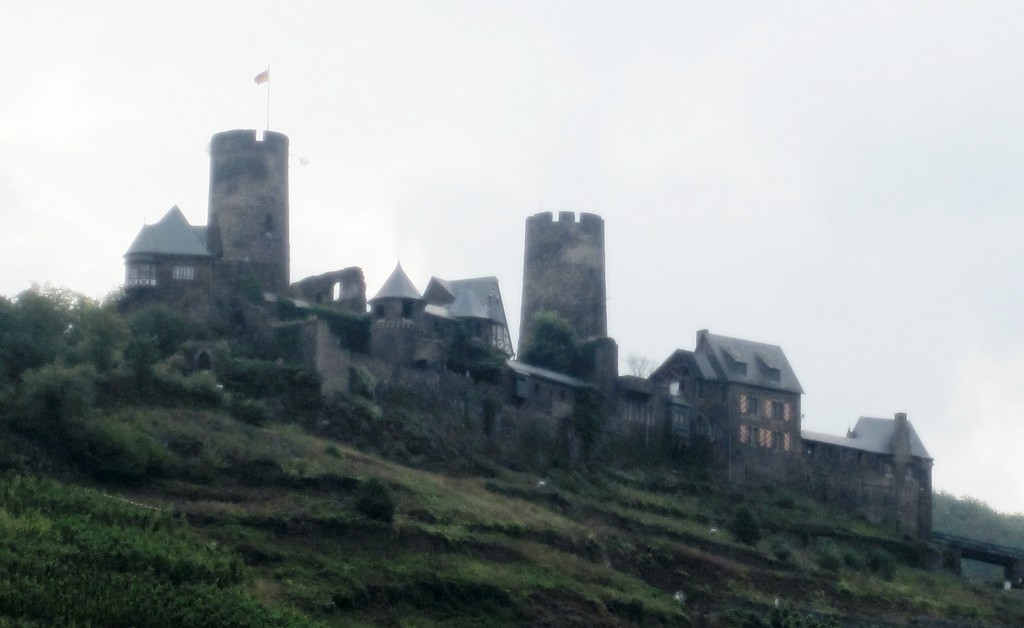 The Castle Metternich in Beilstein is partially in ruins but the tower is intact and part is still used as a residence. It dates from 1268, but was destroyed in 1689; The keep (round tower) was built about 1200. (We didn’t stop here, but we did hike to another castle on a stop upstream in Cochen.)
The Castle Metternich in Beilstein is partially in ruins but the tower is intact and part is still used as a residence. It dates from 1268, but was destroyed in 1689; The keep (round tower) was built about 1200. (We didn’t stop here, but we did hike to another castle on a stop upstream in Cochen.)
This is the town of Cochen with the Reichburg Castle above.
We docked here and spent most of the day here. This is the Reichburg Castle up to which Mary Ann and hiked. We were told by our Program Manager that it would be a strenuous 30 minute hike. We did it in 20 easy minutes. It is generally assumed that the castle was built around the year 1000. In 1294, King Adolf of Nassau pawned the castle and the city of Cochem as well as the surrounding imperial property of about 50 villages to Boemund I of Trier in order to pay for his coronation as German emperor.
In 1294, King Adolf of Nassau pawned the castle and the city of Cochem as well as the surrounding imperial property of about 50 villages to Boemund I of Trier in order to pay for his coronation as German emperor.
The rest of our Orange group took a bus to the castle. We met them there. When the troops of King Louis XIV (called the Sun King) invaded the Rhine and the Moselle area in the war of succession of the Palatinate, Cochem town and castle was occupied in 1688. After the town had been completely occupied by French troops, the castle was set on fire, undermined and blown up in 1689.
When the troops of King Louis XIV (called the Sun King) invaded the Rhine and the Moselle area in the war of succession of the Palatinate, Cochem town and castle was occupied in 1688. After the town had been completely occupied by French troops, the castle was set on fire, undermined and blown up in 1689.
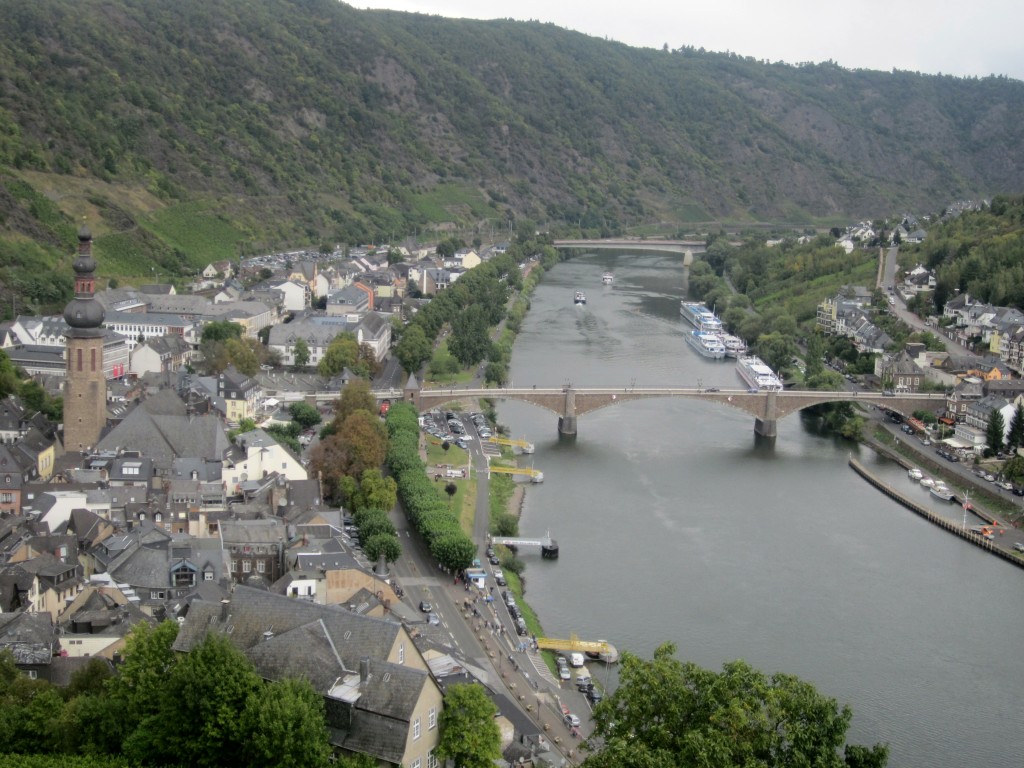 The French Sun King’s troops then almost completely destroyed the town of Cochem. Our ship is moored just beyond the bridge (along with 3 others).
The French Sun King’s troops then almost completely destroyed the town of Cochem. Our ship is moored just beyond the bridge (along with 3 others). The castle remained in ruins until 1868, when a Berlin business man: Louis Ravené, bought the castle grounds and the ruins. Shortly after his purchase he began to rebuild Cochem Castle incorporating the remains of the late Gothic buildings into the main castle structure.
The castle remained in ruins until 1868, when a Berlin business man: Louis Ravené, bought the castle grounds and the ruins. Shortly after his purchase he began to rebuild Cochem Castle incorporating the remains of the late Gothic buildings into the main castle structure.
Since 1978 the castle has been owned by the town of Cochem and is run by “Reichsburg Cochem Ltd.” It is situated on a promenent hill more than 300 feet above the Moselle and is a popular tourist attraction.
We hiked back to town along some narrow strees, past cutesy cafes, and on to the Market Square with it’s half timbered buildings and crowds of tour boat tourists.
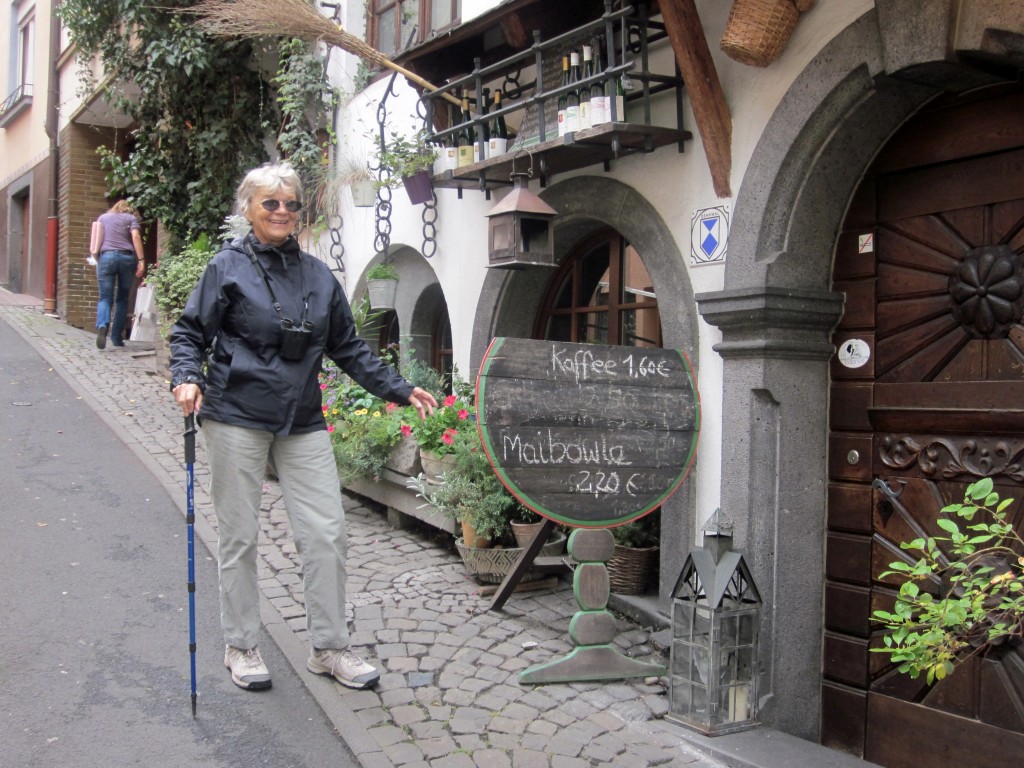
 Our final stop, before returning to our ship, was at a wine and liquor shop. Here we found an interesting liquor dispensary: You would buy a bottle (plain or fancy) and have it filled from these dispensers. We did taste several samples of Moselle wine (dry, medium, and sweet). We bought a medium sweet wine and took it back to the ship. Contrary to big cruise ships, we could bring any alcoholic beverages aboard.
Our final stop, before returning to our ship, was at a wine and liquor shop. Here we found an interesting liquor dispensary: You would buy a bottle (plain or fancy) and have it filled from these dispensers. We did taste several samples of Moselle wine (dry, medium, and sweet). We bought a medium sweet wine and took it back to the ship. Contrary to big cruise ships, we could bring any alcoholic beverages aboard.
Back on the ship we got ready for dinner at 7PM. Tonight’s 5 courses featured a main entree of “Roasted Pork Tenderloin topped with White Mushrooms and Ham Strips on Potato Rusti and Season Vegetables”. After dinner we retired to our “stateroom” to read and sleep away the remainder of Day 5.
On Day 6 we disembarked the ship at a town called Mehring inGermany and boarded buses by Group color (We are the Orange Group). Our destination was the American Cemetery in Luxembourg, It was a drizzly morning and it was a somber gathering. 
The ship provided us with a very nice wreath for us to place in the Chapel. Those of us who served in the Military were invited to participate in the Wreath laying Ceremony. The Cemetery Superintendent said some very touching words about service to country and of those died and are resting in cemeteries like this throughout the world. I got a little teary-eyed. I’m the grey haired guy on the right.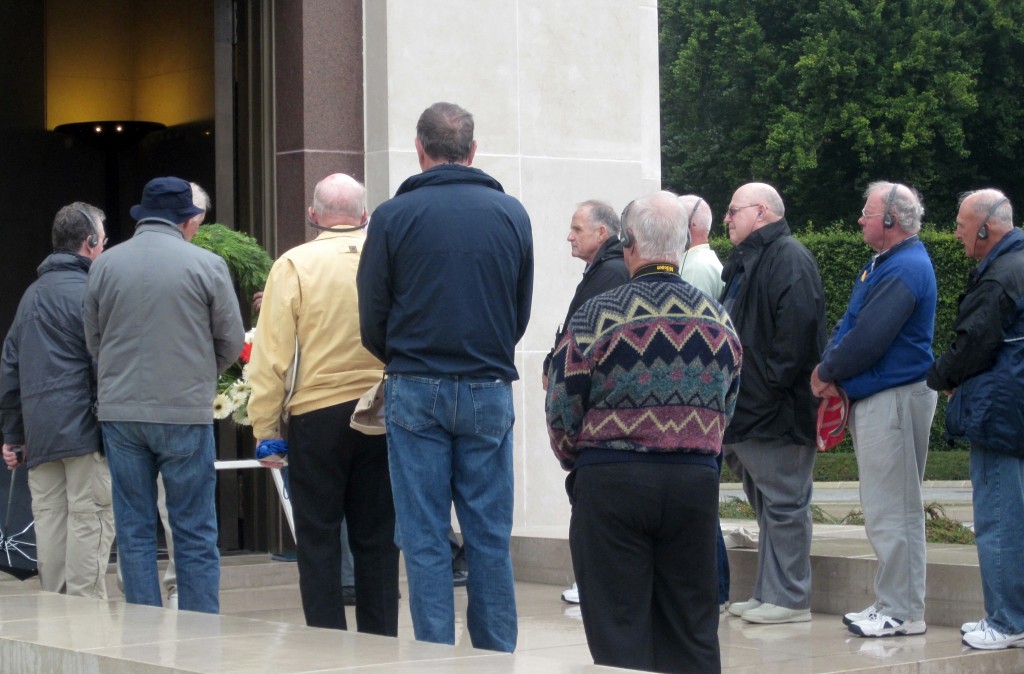
 Under a US-Luxembourg treaty signed in 1951 the US government was granted free use in perpetuity of the land covered by the cemetery, without taxation. The cemetery, which is 50.5 acres in extent contains the remains of 5,076 American service members. On 22 occasions two brothers rest side-by-side in adjacent graves. Most of the interred died during the Battle of the Bulge which was fought nearby in winter 1944/spring 1945.
Under a US-Luxembourg treaty signed in 1951 the US government was granted free use in perpetuity of the land covered by the cemetery, without taxation. The cemetery, which is 50.5 acres in extent contains the remains of 5,076 American service members. On 22 occasions two brothers rest side-by-side in adjacent graves. Most of the interred died during the Battle of the Bulge which was fought nearby in winter 1944/spring 1945.
Two flagpoles overlook the graves area. Situated between the two flagpoles lies the grave of General George S. Patton, jr. His grave was moved here because visitors were trampling the place trying to locate it in amongst the other graves. We departed the American Cemetery and continued on to Luxembourg City.
We departed the American Cemetery and continued on to Luxembourg City.
 Atop of the obelisk stands a gilded bronze statue of a lady, holding out a laurel wreath as if placing it upon the head of the nation. At the foot of the obelisk are two bronze figures, representing those Luxembourger soldiers that volunteered to serve for France; one lies at the base of the statue, having died in service of his country, whilst the other sits, mourning his dead compatriot.
Atop of the obelisk stands a gilded bronze statue of a lady, holding out a laurel wreath as if placing it upon the head of the nation. At the foot of the obelisk are two bronze figures, representing those Luxembourger soldiers that volunteered to serve for France; one lies at the base of the statue, having died in service of his country, whilst the other sits, mourning his dead compatriot.
We moved on with our Orange Group City Guide and visited the Notre Dame Cathedral near Constitution Square.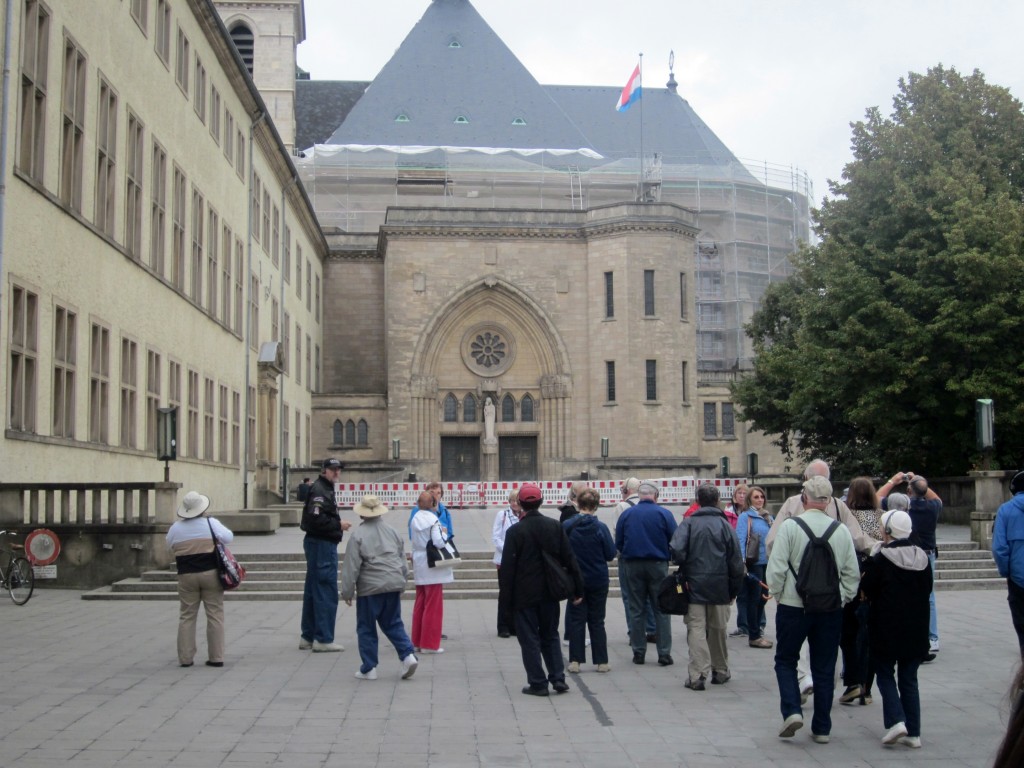 Luxembourg is a small city and this Cathedral was tucked in amongst some larger buildings. Other than the stained glass windows, the church was very plain. its cornerstone was laid in 1613.
Luxembourg is a small city and this Cathedral was tucked in amongst some larger buildings. Other than the stained glass windows, the church was very plain. its cornerstone was laid in 1613.
We then trudged to the Bock Fortress.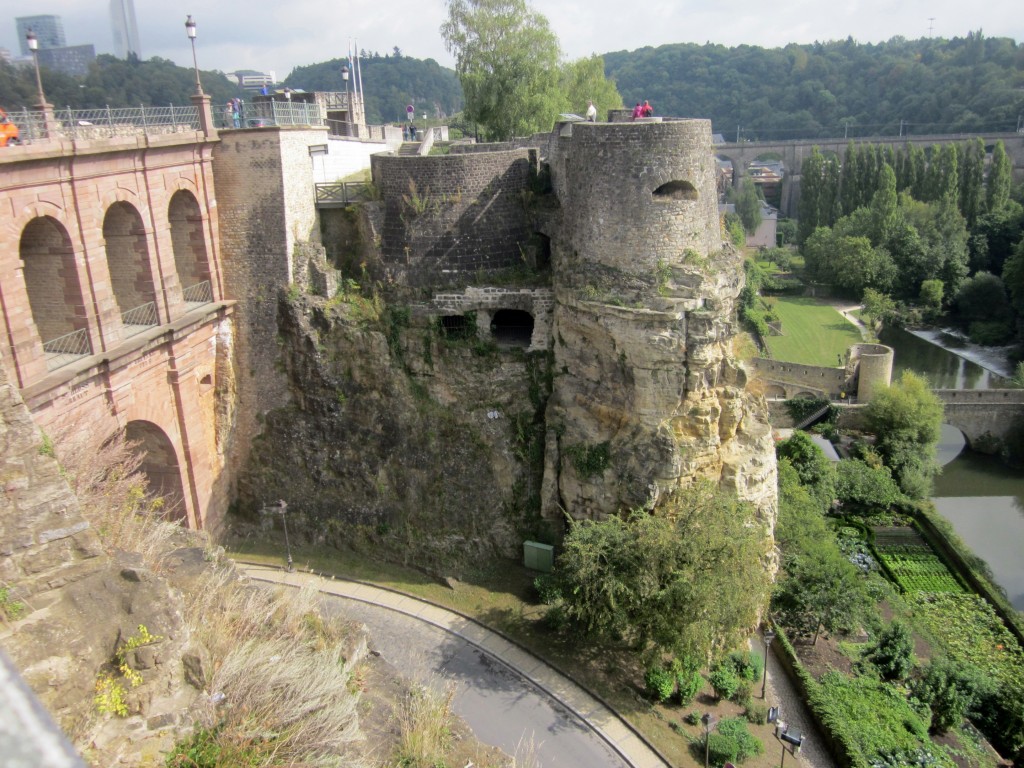 The Bock is a promontory in the north-eastern corner of Luxembourg City‘s old historical district. Offering a natural fortification, its rocky cliffs tower above the River Alzette which surrounds it on three sides. It was here that Count Siegfried built his Castle in 963, providing a basis for the development of the town which became Luxembourg.
The Bock is a promontory in the north-eastern corner of Luxembourg City‘s old historical district. Offering a natural fortification, its rocky cliffs tower above the River Alzette which surrounds it on three sides. It was here that Count Siegfried built his Castle in 963, providing a basis for the development of the town which became Luxembourg.
There are caves in Luxembourg City around and under the Bock. The are called the Casemates. They have been hewn out of the rock face and could shelter an army as well as a bunch of cannons. They helped the Luxembourgers defend the city a number of times.
This is part of the “Place des Armes” in the center of Luxembourg City. This is the “go to” place for lunch and/or dinner. On a personal note: When I worked for the Norton Company in Worcester, MA, I was in charge of several IT persons who did foreign assignments. One of these “Expats” was Bill Flack. He worked at a Norton facility in Bascharage (near Luxembourg City). I had the pleasure of visiting Bill several times to monitor his project and well-being.
On a personal note: When I worked for the Norton Company in Worcester, MA, I was in charge of several IT persons who did foreign assignments. One of these “Expats” was Bill Flack. He worked at a Norton facility in Bascharage (near Luxembourg City). I had the pleasure of visiting Bill several times to monitor his project and well-being.
It was a tough job. He was doing a great job and was apparently quite happy in Luxembourg. We would celebrate his and my good fortune by dining in one of the many fine restaurants in the Place des Armes. Tough assignment, eh?
Here is our Orange Group in the Place des Armes trying to figure out where to have lunch. Amazingly, we were given 15 euros apiece to spend for lunch. Mary Ann and I had made sandwiches at breakfast to eat at lunch time so we ended up with 30 euros in our pocket.
Later in the aftrernoon, we re boarded the bus to meet our ship which was now moored at Remich, when we returned we were treated to a dinner that included an entree of “Oven Roasted Turkey with Natural Gravy, Roasted Garlic mashed Potatoes, Breaded Stuffing with Apples and Celery and served with Green Beans“. A regular Thanksgiving dinner.
To top it off we had “Apple Crumble with Vanilla Ice Cream.and Butterscotch” for dessert.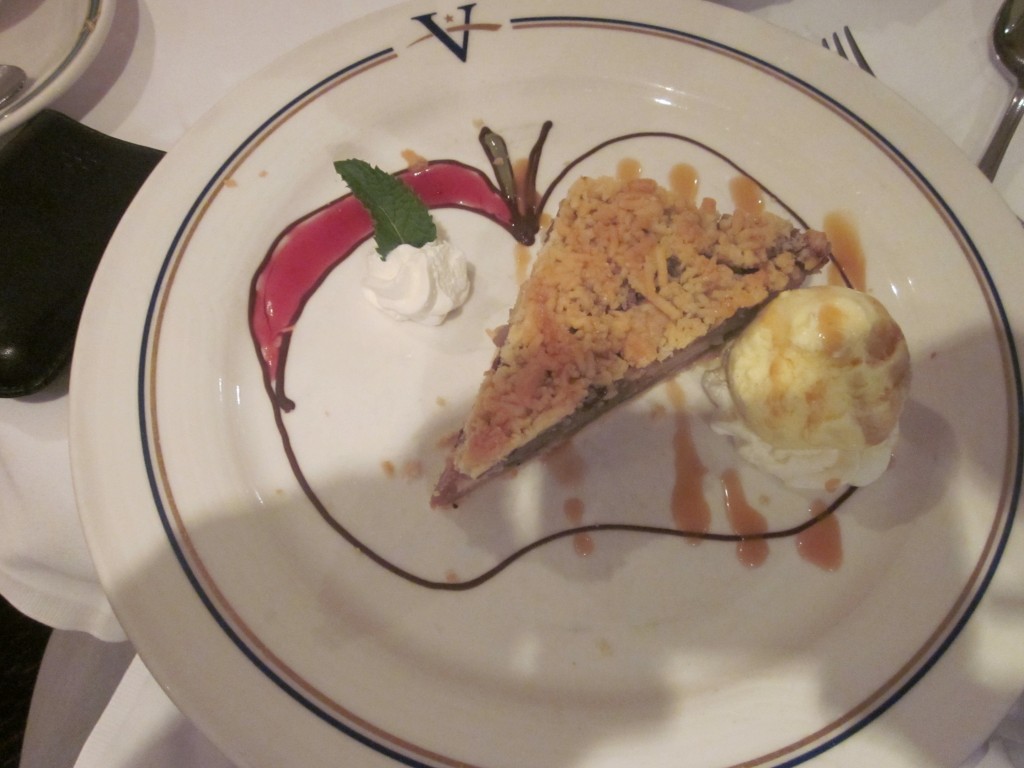 What a way to end our 6th day!
What a way to end our 6th day!


